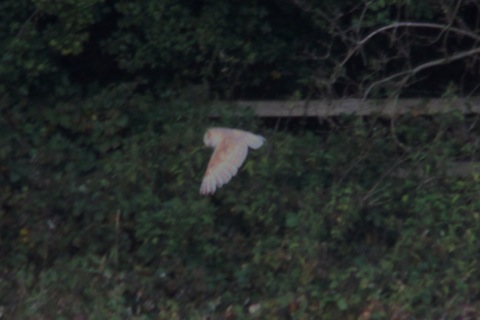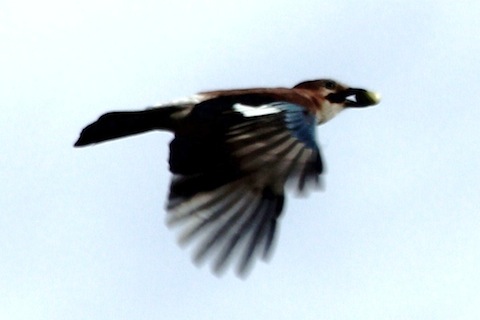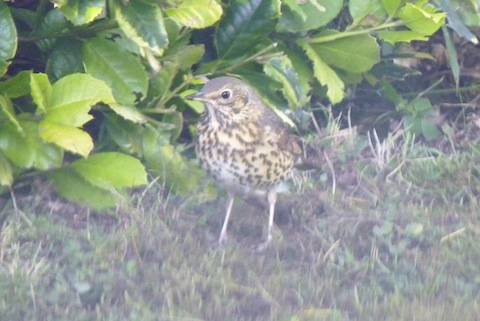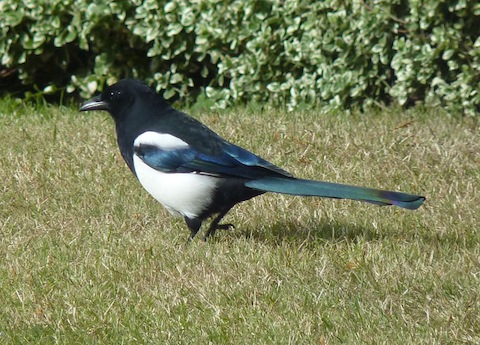 Abraham Lincoln
If given the truth, the people can be depended upon to meet any national crisis...
Abraham Lincoln
If given the truth, the people can be depended upon to meet any national crisis...
 Guildford news...
for Guildford people, brought to you by Guildford reporters - Guildford's own news service
Guildford news...
for Guildford people, brought to you by Guildford reporters - Guildford's own news service
Birdwatcher’s Diary No.21
Published on: 22 Oct, 2012
Updated on: 22 Oct, 2012
By Malcolm Fincham
Although I always consider this to be one of my favourite times of the year, but with daylight hours shortening it does become far more difficult to get out to take photos before the sun goes down.
I have, however, been fortunate in the last few weeks to be able to see a couple of nocturnal birds out hunting in daylight. The first of which has been the barn owl I mentioned at the end of my previous report.
The barn owl will usually hunt from dusk till dawn but is unable to hunt in the rain for fear of its feathers becoming waterlogged.It is also only able to live a few days without food, so our UK climate does it no favours as in captivity barn owls can live up to 20 years, whereas in the wild they’re lucky to live more than two.
On such wet nights, as was Friday, October 5, it has to find a dry shelter and will then have to resort to hunting in daylight.
It was on Saturday, October 6, at about 4.30pm, on arriving at the metal footbridge just beyond Bowers Lock, Burpham, when I was taken by surprise by one coming out of the wooded area. It flew just over my head, then across the river out into the field beyond.
This all happened so quickly I was unable to even contemplate getting my camera out of its bag. I was able to get good views as it spent some time quartering the field and I managed to get some distant pictures and a short video of it resting on a post. Click here to see.
I have managed to get good, although distant, views on several days since.
On Friday, October 12, after taking a brief visit once again to see the barn owl and accompanied by an old friend Martin (Chippy to use his nickname) to see it for the first time, we decided to visit Papercourt water meadow at Send, not far from Old Woking. I had heard reports that another normally nocturnal bird, a short-eared owl, had been seen there.
Short-eared owls breed in more northern parts of the UK, while some venture over from Eastern Europe during winter months. Then they are mostly seen in coastal areas, although as many as six were seen in the Papercourt area last winter.
Just as we were preparing ourselves to be disappointed, one emerged and began hunting in the long grass. This was at about 6pm and unfortunately the light had faded too much for any good pictures.
Sunday, October 14, brought with it some pleasant autumn sunshine and warmth, so I decided to take my wife for a trip and to have lunch at the RSPB reserve at Pulborough Brooks in West Sussex. Once there, I left her to enjoy herself reading a newspaper while I ventured off to see what was about.
On arriving at Hanger Viewpoint I was pleased to see that the female peregrine falcon had arrived back at her wintering perch overlooking the brooks were she spends her day deciding what to have for her lunch – duck being the top choice on her menu.
Unfortunately, leaves still on the trees obscured the peregrine somewhat so my photos were not that successful. I have therefore included one I took back in January and where she spent last winter at the exact same spot. Also click here to see a short video I took of the peregrine, in slow motion, having a tasty snack!
These birds are top predators and the world’s fastest creature, capable of flying at speeds of up to 200mph. Being the most widely distributed of our birds, peregrines breed in areas from the Arctic tundra to the Tropics.
Also recently sighted around the brooks have been redwing and our smallest UK bird of prey the merlin, returning from its northern territory to winter in the south.
Even a few comma butterflies were about making a late appearance in the warm autumn sunshine.
Finally, last week I added a reply to the Local Fauna section of this website under a story about the squirrels, mentioning another critter just as busy collecting nuts. That, of course, as most of you I expect would have guessed is the jay, and I even managed to get a picture of one “red handed” or “acorn beaked”, to be precise…
These birds, although more colourful members of the corvid family which include crows and magpies, are considered vermin by many as during summer months they spend time raiding nests of smaller birds for chicks and eggs.
However, in the autumn they assist in the redistribution of oaks and hazels – perhaps as a penance for their sins? They tend to be very shy, often only noticed by the iridescent blue on their wings or their white rump as they fly away.
I have added one or two pictures here of jays, along with some other more common birds that I seen in the last week or so.
Responses to Birdwatcher’s Diary No.21
Recent Articles
- Burglar Jailed Thanks To Quick Action of Ash Resident
- Highways Bulletin for December
- Birdwatcher’s Diary No.318 Some Pre-Christmas Rambles
- Merry Christmas and a Happy New Year to All Our Contributors and Readers!
- More Units Added to Solums’s Station Redevelopment
- Vehicle Stop on Epsom Road Leads to Prolific Drug Gang Being Put Behind Bars
- Local Political Leaders Respond to Publication of the English Devolution White Paper
- Flashback: Guildford All Lit Up For Christmas – Then And Now
- City Earn Themselves a Three Point Christmas Present
- Mayor’s Diary: December 23 – January 4


Recent Comments
- Jim Allen on Two Unitary Authorities, One Elected Mayor – Most Likely Devolution Outcome for Surrey
- Mike Smith on Two Unitary Authorities, One Elected Mayor – Most Likely Devolution Outcome for Surrey
- Angela Richardson on Two Unitary Authorities, One Elected Mayor – Most Likely Devolution Outcome for Surrey
- Frank Emery on Two Unitary Authorities, One Elected Mayor – Most Likely Devolution Outcome for Surrey
- Paul Kennedy on Two Unitary Authorities, One Elected Mayor – Most Likely Devolution Outcome for Surrey
- Alan Judge on Dumped E-bike Provokes Questions
Search in Site
Media Gallery
Dragon Interview: Local Artist Leaves Her Mark At One of England’s Most Historic Buildings
January 21, 2023 / No Comment / Read MoreDragon Interview: Lib Dem Planning Chair: ‘Current Policy Doesn’t Work for Local People’
January 19, 2023 / No Comment / Read MoreA3 Tunnel in Guildford ‘Necessary’ for New Homes, Says Guildford’s MP
January 10, 2023 / No Comment / Read More‘Madness’ for London Road Scheme to Go Ahead Against ‘Huge Opposition’, Says SCC Leader
January 6, 2023 / No Comment / Read MoreCouncillor’s Son Starts Campaign for More Consultation on North Street Plan
December 30, 2022 / No Comment / Read MoreCounty Council Climbs Down Over London Road Works – Further ‘Engagement’ Period Announced
December 14, 2022 / No Comment / Read MoreDragon Interview: GBC Reaction to the Government’s Expected Decision to Relax Housing Targets
December 7, 2022 / No Comment / Read MoreHow Can Our Town Centre Businesses Recover? Watch the Shop Front Debate
May 18, 2020 / No Comment / Read More



![barn owl [taken on maximum zoom] taking shelter from an oncoming rain shower](https://guildford-dragon.com/wp-content/uploads/2012/10/barn-owl-taken-on-maximum-zoom-taking-shelter-from-an-oncoming-rain-shower.jpg)

















Stephen Balchin
October 25, 2012 at 9:30 pm
I thoroughly enjoyed reading birdwatchers diary 21 and what wonderful pictures.